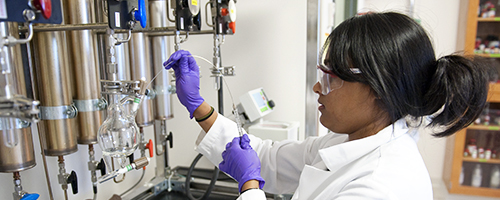Document Type
Article
Publication Date
4-1999
Publication Title
The Journal of Biological Chemistry
Abstract
The high mobility group (HMG) domain is a DNA-binding motif found in the non-histone chromosomal proteins, HMG1 and HMG2, and some transcription factors. Experimental evidence has demonstrated that HMG-domain proteins can play a role in sensitizing cells to the anticancer drug cisplatin. Fluorescence resonance energy transfer (FRET) experiments were performed in the present study to investigate structural changes that accompany complex formation between the HMG domain B of HMG1 and a cisplatin-modified, 20-base pair double-stranded DNA probe containing fluorescein and rhodamine tethered at its two ends. The binding affinity of HMG1 domain B for the cisplatin-modified DNA probe was investigated in fluorescence titration experiments, and a value of 60 ± 30 nm was determined for the dissociation constant. Single photon counting methods were employed to measure the fluorescence lifetime of the fluorescein donor in the presence and absence of HMG1 domain B. These FRET experiments revealed a distance change that was used to estimate a bend angle of 80–95° for the cisplatin-modified DNA upon protein binding. Stopped-flow fluorescence spectroscopic experiments afforded kinetic parameters for HMG1 domain B binding to the cisplatin-modified DNA probe, with k on = 1.1 ± 0.1 × 109m−1 s−1 andk off = 30 ± 4 s−1.
Volume
274
Issue
18
First Page
12346
Last Page
12354
DOI
doi.org/10.1074/jbc.274.18.12346
Rights
© 1999 by The American Society for Biochemistry and Molecular Biology, Inc.
Version
Version of Record
Recommended Citation
Jamieson, Elizabeth R.; Jacobson, Matthew P.; Barnes, Carmen M.; Chow, Christine S.; and Lippard, Stephen J., "Structural and Kinetic Studies of a Cisplatin-modified DNA Icosamer Binding to HMG1 Domain B*" (1999). Chemistry: Faculty Publications, Smith College, Northampton, MA.
https://scholarworks.smith.edu/chm_facpubs/68


